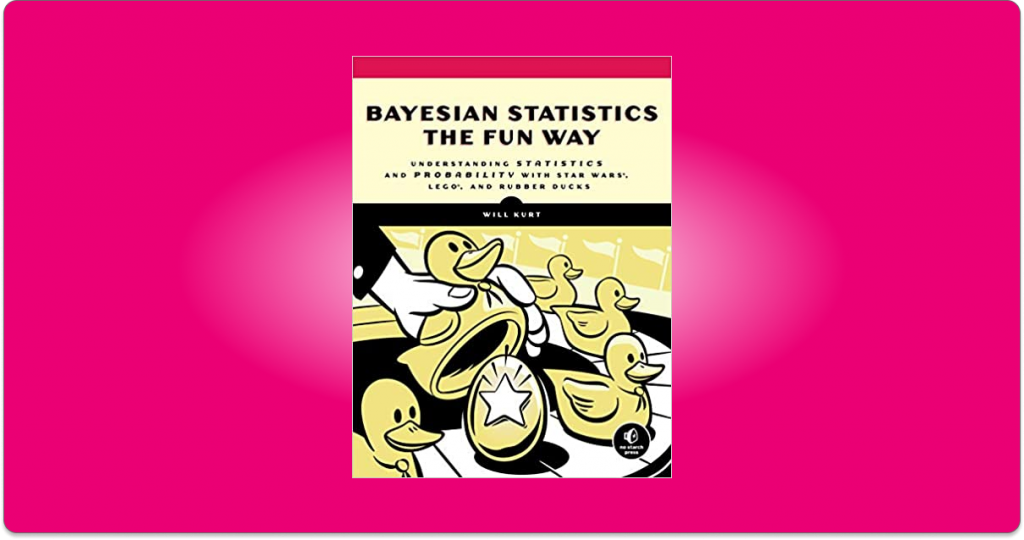An Introduction to Bayesian Statistics with awesome, fun, and crazy examples. Learn Bayesian Statistics the fun way!

The following is a review of the book Bayesian Statistics the Fun Way: Understanding Statistics and Probability with Star Wars, LEGO, and Rubber Ducks by Will Kurt.
Review
The book Bayesian Statistics the fun way offers a delightful and fun read for those looking to make better probabilistic decisions using unusual and highly illustrative examples. It will give you a complete understanding of Bayesian Statistics through simple explanations and amusing examples that go from calculating how likely Han Solo is to survive a flight through an asteroid field to calculating the probability of seeing an UFO.
Don’t think however, that this is the typical Bayesian Statistics for Dummies book. The topics covered are complex, however they are explained in a really straightforward and simple manner, stripping all complexity from them and making them approachable to everybody.
The problem with topics like statistics, algebra, maths, and probability is that almost always they are explained in a flat-tone, boring and un-practical manner. Bayesian Statistics the Fun way changes this. You will have fun while learning real skills, like how to:
– Measure your own level of uncertainty in a conclusion or belief
– Calculate Bayes theorem and understand what it’s useful for
– Find the posterior, likelihood, and prior to check the accuracy of your conclusions
– Calculate distributions to see the range of your data
– Compare hypotheses and draw reliable conclusions from them
With Bayesian Statistics the Fun Way you will learn to get the most value from your data, the difference between frequentist and Bayesian statistics and much more! Take a look at the contents to see.
If you’ve never head of Bayesian statistics or Bayes Theorem, you can learn about them in this awesome video by Veritasium.
Contents
Bayesian Statistics the fun way presents an amusing and easy to read introduction to bayesian statistics and it is probably the best bayesian statistics book to start with. After reading this book we will have a solid foundation of how they work, and will be prepared for more advanced readings like Statistical Rethinking.
The contents of the book are the following:
Part I: Introduction to Probability.
- Chapter 1: Bayesian Thinking and everyday reasoning.
- Chapter 2: Measuring Uncertainty.
- Chapter 3: The Logic of Uncertainty
- Chapter 4: Creating a Binomial Probability Distribution
- Chapter 5: The Beta distribution
Part II: Bayesian Probability and Prior Probabilities.
- Chapter 6: Conditional Probability
- Chapter 7: Bayes’ Theorem with LEGO
- Chapter 8: The Prior, Likelihood, and Posterior of Bayes’ theorem
- Chapter 9: Bayesian Priors and Working with probability distributions
Part III: Parameter Estimation
- Chapter 10: Introduction to Averaging and Parameter Estimation
- Chapter 11: Measuring the spread of our data
- Chapter 12: The normal distribution
- Chapter 13: Tools of parameter estimation: The PDF, CDF, and Quantile Function
- Chapter 14: Parameter estimation with Prior probabilities
Part IV: Hypothesis testing – The Heart of Statistics
- Chapter 15: From Parameter Estimation to Hypothesis testing: Building a Bayesian A/B test
- Chapter 16: Introduction to the Bayes Factor and the Posterior Odds: The competition of ideas
- Chapter 17: Bayesian Reasoning in the Twilight Zone
- Chapter 18: When Data doesn’t convince you
- Chapter 19: From hypothesis testing to parameter estimation
As you can see, despite of the easy going tone of the book that we have remarked previously, the contents build up from easy to become quite advanced. Each chapter is short, and can be read in one sitting. Also, every chapter ends with a series of exercises. We recommend doing just this to make the most out of the reading: sparing 1 hour to read through a chapter in one sitting, and completing the associated exercises, which are solved in Appendix C of the book.
Appendix A includes a really cool introduction to statistics with the R programming language, and appendix B contains the basic math notions you need to understand the book; don’t worry they are easy and you most likely do not need to visit this appendix.
Summary
Bayesian Statistis the Fun way presents an easy to read, friendly introduction to Bayesian statistics, that will help you to build a flexible and robust framework for working through a wide range of statistical problems: calculating distributions, comparing hypothesis, understanding conditional probabilities, likelihood, and much more! A fantastic read for those that are looking to finally understand statistics!
Kudos to Will Kurt.
You can buy the book at the best price on Amazon here:
Bayesian Statistics the fun way
- Book - bayesian statistics the fun way: understanding statistics and probability with star wars, lego, and rubber ducks
- Language: english
- Binding: paperback
- Kurt, Will (Author)
- English (Publication Language)
Also, if you want to further learn statistics, take a look at our section on Probability and Statistics Courses. Also, some similar resources that you might like are:
- Fun little introduction to probability in Machine Learning and the main with a mysterious but easy example where each of the main terms of probability are introduced.
- Harvard’s Statistics 110 course. This is a larger resource, in case you don’t only want to learn the fundamentals, but dive deeper into the wonderful world of statistics.
- Bayesian statistics the fun way: another awesome book which we have reviewed, with great, easy examples to teach you all the fundamentals of bayesian statistics.
Thank you for reading How to Learn Machine learning, and have a wonderful day!
Subscribe to our awesome newsletter to get the best content on your journey to learn Machine Learning, including some exclusive free goodies!


